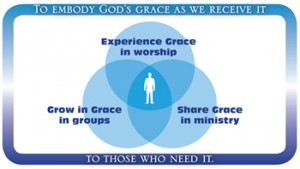We just completed the second track of Auxano’s Vision co::Lab at Gateway Community Church in Houston. This is a portion of my notes from the day long session. I wrote previously about the Lab and reasons why I’m attending here.

One of the greatest benefits to being in this learning community is the opportunity to make new friends. Church leaders participating include Wendell Hutchins, Church of Champions; Jim Martin, The River UMC; Steven Barr, LifeWorship Ministries; Matt Neely, The Watershed Church; and Andy Sytsma, New Life Church. Our lead navigator is Will Mancini, Auxano founder and visionary captain.
The primary objective for this session was to learn how to identify and develop The Kingdom Concept. The one thing your church does better than 10,000 others.
Focusing on mission is important to my current thinking and activity regarding media and technology in the church. So I leaned in close to listen.
Finding the sweet spot
Up front, we were told that getting to a single unifying purpose for any individual or organization would be hard work. Mancini said this was because Church leaders had not been trained to think that way. In the past, traditional church models influenced leaders toward the idea of doing a number of things well.
Mancini referred to the hugely successful book, The Purpose Driven Church, where Rick Warren identified five purposes of the church: worship, discipleship, fellowship, mission and ministry. Building vision and mission around those five aspects of ministry enabled churches to generally stay on course.
In today’s challenging climate of declining and plateaued churches, however, Mancini believes greater focus and clarity of purpose are needed. His main point was that God has a unique plan for every church. You just have to be willing to slow down long enough to discover it, he stressed.
Think of it, Mancini told us, as finding your organizational sweet spot; the place where your church’s unique experiences flow as a body of Christ. What your church can do better than any other church.
This thinking may sound familiar. Mancini paid homage to the book Good to Great, where Jm Collins called the idea of doing one thing better than anyone else in the world, ‘The Hedgehog Concept.’ Mancini has creatively reinterpreted the concept for a local church context.
We weren’t left hanging with theory. Mancini took us through the practical process of getting to The Kingdom Concept. We learned that it begins by considering three sets of questions, represented by three concentric circles, stacked pyramid style. Each circle, a different theme of exploration, was designed to help unpack the various expressions of your church’s uniqueness.
The following is a small sample of his questions.
Your Kingdom Concept
Circle One: Local Predicament – Answers the question, “What are the unique needs and opportunities where God has placed you?” What burning issues are alive in the public’s eye and brought to attention by the media? How would you describe the ‘atmosphere of lostness’ in your community? Does the history of your community bring to light any spiritual strongholds?
Circle Two: Collective Potential – Answers the question, “What are the unique resources and capabilities that God brings together in your church?” If a guest visited your church several times and answered the question, ‘What did you like best about that church?’ what would they say? If your church was immediately uprooted from the community, what would people in the community feel is missing? What spiritual gifts seem to be more prominent in your church?
Circle Three: Apostolic Esprit – Answers the question, “What particular focus most energizes and animates your leadership?” What one thing bothers you most about the world? What do you tend to pray for the most? If you knew you couldn’t fail, what one thing would you pursue for God?
Getting through the entire list of questions will often take a period of weeks or months. The Kingdom Concept is found where the three circles overlap. The ‘sweet spot.’ The final expression comes, he said, when you can fill in the blank below with a clear and concise phrase…
Our church glorifies God and makes disciples by:
________________________________________________________________
We were cautioned about keeping some things out of The Kingdom Concept:
1. Church growth projections, capital campaigns and building plans
2. Flashy mission language or the mission language of another church
3. Random thinking about future possibilities
Mancini likes to quote his mentor, Professor Howard Hendricks, Dallas Theological Seminary. With reference to point #3, he recalled Hendricks saying, “Can dos make it hard to know what one must do for God.”
Chapelwood United Methodist Church, under the leadership of Senior Pastor Jim Jackson, identified their ‘must do’ like this: To Embody God’s Grace As We Receive It To Those Who Need It
 Mancini recounted a remarkable event to illustrate how Chapelwood knows its people are living out their unique mission mandate.
Mancini recounted a remarkable event to illustrate how Chapelwood knows its people are living out their unique mission mandate.
“A number of years ago, on a Sunday, I came to Chapelwood to steal a car. A parking attendant saw me. Instead of calling the police, he invited me into the service. What I found that day was something that I couldn’t steal. I found God’s grace.” (Chapelwood Ministry Leader)
Mancini said Chapelwood’s expression of its Kingdom Concept, had the ‘OOZE Factor.’ O-rginal O-rganic Zeroed-in E-xtravagant…and S-weet.
Question: What does your church do better than 10,000 others?